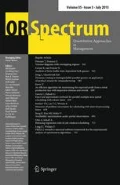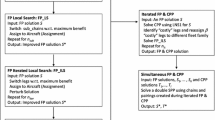Abstract
A prominent problem in airline crew scheduling is the pairings or Tour-of-Duty planning problem. The objective is to determine a set of pairings (or Tours-of-Duty) for a crew group to minimise the planned cost of operating a schedule of flights. However, due to unforeseen events the performance in operation can differ considerably from planning, sometimes causing significant additional recovery costs. In recent years there has been a growing interest in robust crew scheduling. Here, the aim is to find solutions that are “cheap” in terms of planned cost as well as being robust, meaning that they are less likely to be disrupted in case of delays. Taking the stochastic nature of delays into account, Yen and Birge (Transp Sci 40:3–14, 2006) formulate the problem as a two-stage stochastic integer programme and develop an algorithm to solve this problem. Based on the contradictory nature of the goals, Ehrgott and Ryan (J Multi-Criteria Decis Anal 11:139–150, 2002) formulate a bi-objective set partitioning model and employ elastic constraint scalarisation to enable the solution by set partitioning algorithms commercially used in crew scheduling software. In this study, we compare the two solution approaches. We improve the algorithm of Yen and Birge (Transp Sci 40:3–14, 2006) and implement both methods with a commercial crew scheduling software. The results of both methods are compared with respect to characteristics of robust solutions, such as the number of aircraft changes for crew. We also conduct experiments to simulate the performance of the obtained solutions. All experiments are performed using actual schedule data from Air New Zealand.
Similar content being viewed by others
References
Anbil R, Forrest J, Pulleyblank W (1998) Column generation and the airline crew pairing problem. Doc Math Extra volume ICM III: 677–686
Barnhart C, Johnson EL, Savelsbergh MWP, Vance PH (1998) Branch-and-price: column generation for solving huge integer programs. Oper Res 46: 316–329
Barnhart C, Cohn A, Johnson E, Klabjan D, Nemhauser G, Vance P (2003) Airline crew scheduling. In: Hall R(eds) Handbook of transportation science.. Kluwer, Dordrecht, pp 493–521
Ehrgott M, Ryan D (2002) Constructing robust crew schedules with bicriteria optimization. J Multi-Criteria Decis Anal 11: 139–150
Ehrgott M, Ryan D (2003) The method of elastic constraints for multiobjective combinatorial optimization and its application in airline crew scheduling. In: Tanino T, Tanaka T, Inuiguchi M(eds) Multi-objective programming and goal-programming.. Springer, Berlin, pp 117–122
Rosenberger JM, Schaefer AJ, Goldsman D, Johnson EL, Kleywegt A, Nemhauser GL (2000) Simair: a stochastic model of airline operations. In: Joines J, Barton P, Fishwick P, Kang K (eds) Proceedings of the 2000 winter simulation conference, pp 1118–1122
Rosenberger JM, Schaefer AJ, Goldsman D, Johnson EL, Kleywegt A, Nemhauser GL (2002) A stochastic model of airline operations. Transp Sci 36: 357–377
Ryan DM, Falkner J (1988) On the integer properties of scheduling set partitioning models. Eur J Oper Res 35: 442–456
Ryan DM, Foster BA (1981) An integer programming approach to scheduling. In: Wren A(eds) Computer scheduling of public transport.. North-Holland, Amsterdam, pp 269–280
Schaefer AJ, Johnson EL, Kelywegt AJ, Nemhauser GL (2005) Airline crew scheduling under uncertainty. Transp Sci 39: 340–348
Shebalov S, Klabjan D (2006) Robust airline crew pairing: move-up crews. Transp Sci 40: 300–312
US Department of Transportation (2007) Airline on-time performance data. Bureau of Transportation Statistics. http://www.transtats.bts.gov
Yen JW, Birge JR (2006) A stochastic programming approach to the airline crew scheduling problem. Transp Sci 40: 3–14
Author information
Authors and Affiliations
Corresponding author
Rights and permissions
About this article
Cite this article
Tam, B., Ehrgott, M., Ryan, D. et al. A comparison of stochastic programming and bi-objective optimisation approaches to robust airline crew scheduling. OR Spectrum 33, 49–75 (2011). https://doi.org/10.1007/s00291-009-0164-9
Published:
Issue Date:
DOI: https://doi.org/10.1007/s00291-009-0164-9




